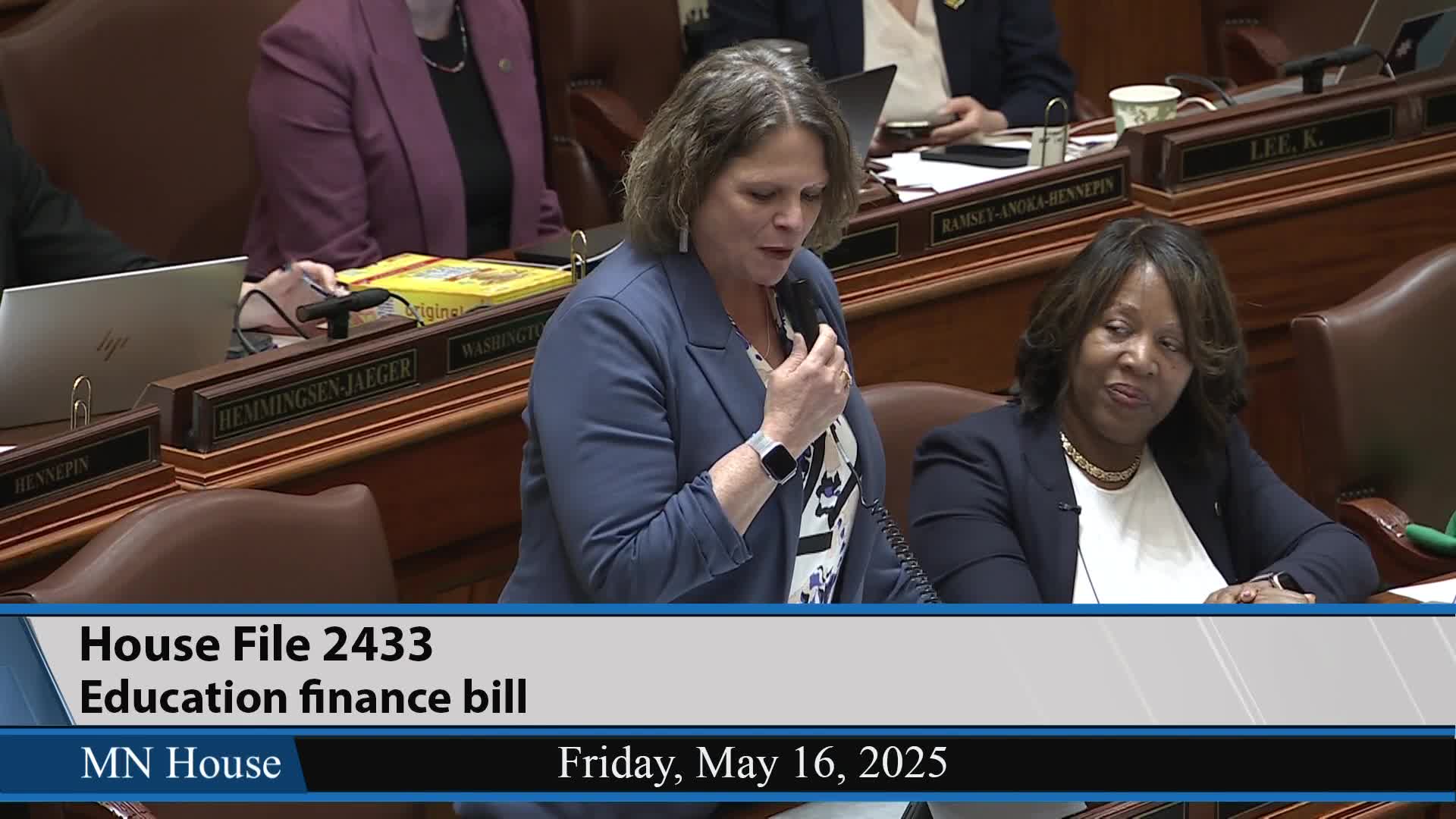Minnesota Education Committee debates funding flexibility and compensatory aid for schools
May 18, 2025 | 2025 Legislature MN, Minnesota
This article was created by AI summarizing key points discussed. AI makes mistakes, so for full details and context, please refer to the video of the full meeting. Please report any errors so we can fix them. Report an error »

In a pivotal moment for Minnesota's education system, the House passed the education finance bill, HF2433, on May 16, 2025, marking a significant step toward addressing the funding needs of schools across the state. The atmosphere in the chamber was charged with a sense of collaboration and urgency as lawmakers from both sides of the aisle came together to discuss the bill's provisions and implications for students and educators.
The bill, while not without its compromises, aims to allocate $40 million in the first biennium to support the Reid Act, which focuses on enhancing educational resources. Representative Krisha, who played a crucial role in the bill's development, expressed gratitude for the collaborative efforts of committee members and staff, emphasizing the importance of listening to concerns and working together to find solutions. "It reflects a compromise that a dynamic of a tide house requires for us to fund our schools," he noted, highlighting the necessity of flexibility in funding streams to meet the diverse needs of school districts.
Among the key provisions, the bill links the general education formula to inflation, ensuring that funding keeps pace with rising costs. This move is seen as a vital step in providing stability and predictability for school districts, especially in light of recent federal funding cuts that have left many programs vulnerable. Lawmakers voiced their commitment to protecting essential services, including support personnel like counselors and social workers, while also addressing the need for ongoing investments in educational infrastructure.
However, the bill is not without its challenges. A contentious point of discussion was the decision to remove unemployment insurance for hourly school workers after the summer of 2028. Many representatives voiced their disappointment, arguing that these workers play a critical role in the educational ecosystem and deserve the same benefits as their counterparts in other sectors. The hope remains that further negotiations in the conference committee will lead to a resolution that supports these essential staff members.
As the debate unfolded, representatives also raised concerns about the compensatory aid formula, which has faced criticism for failing to adequately support students from low-income backgrounds. The establishment of a task force to revisit this formula was welcomed as a necessary step toward ensuring that funding is effectively targeted to those who need it most.
In conclusion, the passage of HF2433 represents a significant milestone in Minnesota's ongoing efforts to enhance educational funding and support for schools. While the bill addresses many pressing needs, it also sets the stage for further discussions on how to best allocate resources and support the state's educators and students. As lawmakers prepare for the next steps in the legislative process, the focus remains on fostering a collaborative environment that prioritizes the educational success of all Minnesota students.
The bill, while not without its compromises, aims to allocate $40 million in the first biennium to support the Reid Act, which focuses on enhancing educational resources. Representative Krisha, who played a crucial role in the bill's development, expressed gratitude for the collaborative efforts of committee members and staff, emphasizing the importance of listening to concerns and working together to find solutions. "It reflects a compromise that a dynamic of a tide house requires for us to fund our schools," he noted, highlighting the necessity of flexibility in funding streams to meet the diverse needs of school districts.
Among the key provisions, the bill links the general education formula to inflation, ensuring that funding keeps pace with rising costs. This move is seen as a vital step in providing stability and predictability for school districts, especially in light of recent federal funding cuts that have left many programs vulnerable. Lawmakers voiced their commitment to protecting essential services, including support personnel like counselors and social workers, while also addressing the need for ongoing investments in educational infrastructure.
However, the bill is not without its challenges. A contentious point of discussion was the decision to remove unemployment insurance for hourly school workers after the summer of 2028. Many representatives voiced their disappointment, arguing that these workers play a critical role in the educational ecosystem and deserve the same benefits as their counterparts in other sectors. The hope remains that further negotiations in the conference committee will lead to a resolution that supports these essential staff members.
As the debate unfolded, representatives also raised concerns about the compensatory aid formula, which has faced criticism for failing to adequately support students from low-income backgrounds. The establishment of a task force to revisit this formula was welcomed as a necessary step toward ensuring that funding is effectively targeted to those who need it most.
In conclusion, the passage of HF2433 represents a significant milestone in Minnesota's ongoing efforts to enhance educational funding and support for schools. While the bill addresses many pressing needs, it also sets the stage for further discussions on how to best allocate resources and support the state's educators and students. As lawmakers prepare for the next steps in the legislative process, the focus remains on fostering a collaborative environment that prioritizes the educational success of all Minnesota students.
View full meeting
This article is based on a recent meeting—watch the full video and explore the complete transcript for deeper insights into the discussion.
View full meeting
